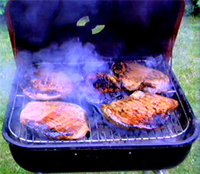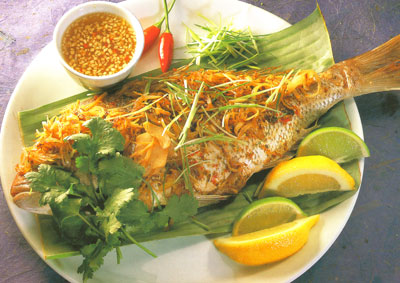Grilling Method and Process
 Firstly, place the food on the grill to start cooking and "mark" it. It
does make a difference which side of the food goes onto the grill first.
The best looking, or "presentation" side always goes face down on the
grill first. Once the item is turned to the second side, it should not
usually be turned again. Firstly, place the food on the grill to start cooking and "mark" it. It
does make a difference which side of the food goes onto the grill first.
The best looking, or "presentation" side always goes face down on the
grill first. Once the item is turned to the second side, it should not
usually be turned again.
Most diners expect to see the familiar
cross-hatch marks on grilled food at a restaurant. While it is certainly
possible to grill foods correctly without giving them the trademark
"grid", it is not difficult to do. It has the added advantage of
"releasing" the food from the grill before the presentation side sticks
and tears.
To mark foods on a grill or broiler, gently
work the spatula under the food and give it a quarter turn (90oF/32oC).
Let it continue to cook on the first side another minute or two before
turning the food completely over.
Whenever a barbecue sauce is used, it is
usually a good idea to apply several thin coats, rather than one heavy
coat. The more light coats, the better the finished color, flavor, and
appearance of the food.
Once the first side is done, turn once to
cook on the second side. Since most foods cooked by grilling or broiling
are relatively thin and tender, they should not require much more cooking
time, once they have been turned. Thicker cuts, or those that must be
cooked to a higher internal doneness may need to move to the cooler
portion of the grill, so that they don't develop a charred exterior. Or,
they may be removed from the grill altogether and allowed to finish
cooking in the oven. For banquets, it may be helpful to quickly mark foods
on the grill, just barely cooking the outer layers of the food. Then, they
can be laid out on sheet or pans, and finished in the oven. This allows
you to greatly expand the potential output of your grill. Exercise extreme
care in chilling the food quickly if it is to be held for any appreciable
amount of time.
If you are using a barbecue sauce or glaze,
you will probably need to turn the item more than once, however. Brush
barbecue sauce on the top of the food and turn it repeatedly, until a good
shiny glaze and crust have developed.
When finish to the desired doneness, serve
at once. Most red meats, some fish, and duck breasts may be prepared to a
range of doneness. Most other foods are cooked until they are cooked
through. In either case, a deft touch and a sixth sense about when a food
is properly cooked is a great boon to a grill chef. Rely on a combination
of previous experience and sensory date - the way a food looks, feels, and
smells - to guide you.
Barbecued Whole Fish
Recipe
Preparation time: 20 minutes + 20 minutes
marinating
Total cooking time: 25 minutes
Serves: 4-6

Ingredients:
750 g (1.5 lb) small snapper or bream,
cleaned and scaled
2 teaspoons green peppercorns, finely
crushed
2 teaspoons chopped red chili
3 teaspoons fish sauce
1 tablespoon oil
2 medium onions, finely sliced
4 cm (1.5 in) piece fresh ginger, cut into
very thin slices
3 cloves garlic, cut into very thin slices
2 teaspoon sugar
4 spring onions, cut into 4 cm (1.5 in)
pieces, then finely shredded
Lemon and garlic dipping sauce, to serve
Method:
Wash the fish inside and out and pat dry
with paper towels. Cut 2 diagonal slashes into the thickest part of the
fish on both sides. Place the peppercorns, chili and fish sauce in a food
processor or mortar and pestle, and process or grind until a paste is
formed. Brush the paste lightly over the fish, cover and refrigerate for
20 minutes.
Heat the barbecue until very hot; lightly
brush it with oil. Cook the fish for 8 minutes on each side, or until the
flesh flakes easily when tested. While the fish is cooking, heat the oil
in a frying pan; add the onion and cook over medium heat, stirring, until
golden. Add the ginger, garlic and sugar and cook for 3 minutes.
Place the fish on a serving plate, top with
the onion mixture, sprinkle over the spring onion and serve immediately
with lemon and garlic dipping sauce and hot steamed rice.

Happy Grilling,
Carol |

